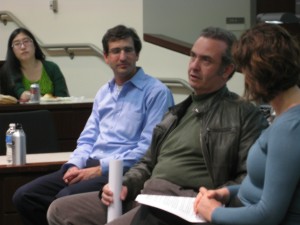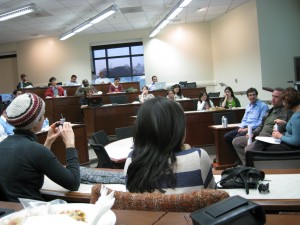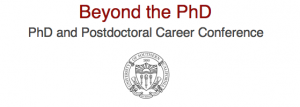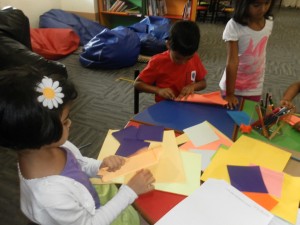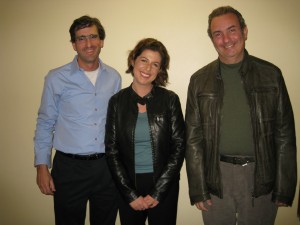
(from left) Laird Malamed, Laurel Felt, and George Rose grin post-panel discussion on the business of impact games
While the definition (as well as the terminology — impact game vs. serious game) is contested, one might characterize an impact game as a game that has been designed for a purpose beyond pure entertainment. While the game must entertain in order to effectively engage users’ attention, it aims to impact users’ knowledge, attitudes, and/or practices. Impact games have taught players about international conflicts (as in USC Impact Games co-chair Susana Ruiz’s Darfur is Dying), emotional regulation strategies (as in GameDesk‘s Dojo, the focus of my dissertation), and the pathways to and protocols for college access (as in USC Collegeology‘s Application Crunch and Mission: Admission). They have provided contexts for exercising (as in the Nintendo Wii and the Xbox Kinect), rehabilitating (as in the work of Marientina Gotsis with the USC Creative Media & Behavioral Health Center), accessing tailored health plans (as in My Fitness Coach 2), and building community (as in USC Annenberg Innovation Lab‘s ParTour).
A FEW TAKEAWAYS
According to Laird:
Funding — Sponsorship seems a more reliable source of funding than short-term and/or volatile grants. Find companies that support your goals, that want to support/celebrate these goals — principally for-profit businesses that would benefit from being associated with the project. If the outcome is social awareness/understanding, that’s a tougher sell…
Sustainability — Can’t think of a game in absence of a sustainability model, even going into the concept of it, even outlining/coming up with a design. It’s okay to say, in the case of an impact game, there is no business model for this, but what’s not okay is to add it in at the end (similar argument goes for assessment). When you’re evaluating design and deciding what to cut, you don’t cut the things that you’re selling/marketing/getting sponsored for. Another lens to look through that should be done in an iterative fashion. Take multiple passes to consider technology, art, and sustainability factors. No one lens is the right blanket way to do it.
Horizon — Are you making one per year or one every few years? Does it have to survive more than three years (that’s a long time for an interactive project to survive, it will look dated)? It’s more like you’re creating an event that will be online for a 1000 days vs. creating an enduring product. iPhone games being a good example to look at in terms of life-span synced with business plan and goals.)
According to George:
Product development and marketing — You’re creating a product that does something novel, or does better or more efficiently a legacy product. You must overcome built-in resistance from the idea that games and screentime are frivolous and unnecessary, reading books onscreen isn’t real reading, etc. In-fighting among entrenched, interested entities.
Future directions — Impact games are used robustly in Europe to inform citizens about corporate social responsibility. Stateside, we may see growth in this sector as well as in the areas of exergames and rehabilitation, among others.
—–
Here is our PR blurb, a better-than-nothing video of the event, our agenda, and a few pix snapped during the discussion and immediately afterwards:
PUBLICITY
The Business of Impact Games: A moderated discussion with gaming executives
From Darfur is Dying to Sim City, the field of “impact” or “serious” games is on the rise. Panelists will discuss what it takes to build up a market for these games and offer strategies for developing and selling commercial products. They will also explore these games’ tremendous potential for inspiring global change and bringing awareness to various issues, from education to public health.
Panelists:
Laird Malamed, Adjunct Faculty, USC School of Cinematic Arts and President, Creative Learning Technologies;
George Rose, former Chief Legal Officer and Chief Public Policy Officer and current Senior Consultant to Chief Executive Officer of Activision Blizzard
Moderator:
Laurel Felt, Doctoral Candidate at USC Annenberg School for Communication & Journalism
AGENDA
1. Introductions: (5:05-5:10 pm)
Tell me more about your background and experience. Chronologically, please share your titles, affiliations, and years spent in each position.
2. Definitions: (5:10-5:20 pm)
What are “serious” or “impact” games? Why the vernacular distinction? What are the potential problems as well as potential benefits of each term? Considering the interdisciplinary nature of this field, how should we move forward regarding a shared (if not, common) language? Issues of “perception” (i.e. games, in the general public’s mind, are not to be taken seriously).
3. Personal Connections: (5:20-5:35 pm)
Why do YOU care about serious or impact games? What brought you from a more purely commercial origin to working in this philanthropically-influenced domain? Was there a key moment or insight, a seminal piece of literature or game, that changed your way of thinking and/or inspired a new agenda? Why should the commercial game industry take this field seriously? How is productive collaboration fostered in a space typically (and perhaps, necessarily) inhabited by multiple cultures?
4. Business Considerations: (5:35-5:50 pm)
Let’s talk about practical strategies for developing, disseminating and selling these products/experiences commercially. How do we assemble productive diverse teams, monetize ethically and significantly, and get these games out there? How can teams and businesses plan in a sustainable way?
How can academic game programs and business programs educate students to co-experiment and innovate around new business models for projects/services that seek to make a profit as well as advance social justice and education? For example, past one grant-funded project, how can a studio/developer continue to create high-quality products and keep a roof over her head while competing (or, at least, existing in parallel with) with richly funded commercial entities?
5. Personal Insights/Advice/Lessons Learned + Future Forecasting: (5:50-6 pm)
What have you discovered as a result of your experience? What would you advise our audience members in terms of what TO do and what NOT to do? Five, 10, and 20 years down the pike: What do you see in terms of this field? Paint that picture (in terms of the culture, the technology, and the creative aspects).
6. Q&A: (6-6:20)
Let’s hear what the people have to say!


